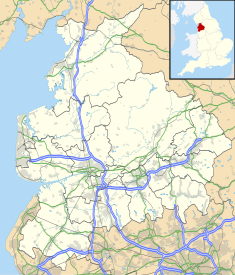Accrington Town Hall
| Accrington Town Hall | |
|---|---|
 Accrington Town Hall | |
| Location | Blackburn Road, Accrington |
| Coordinates | 53°45′12″N 2°21′55″W / 53.7532°N 2.3653°W |
| Built | 1858 |
| Architect | James F. Green and T. Birtwhistle |
| Architectural style(s) | Neoclassical style |
Listed Building – Grade II* | |
| Official name | Town Hall |
| Designated | 9 March 1984 |
| Reference no. | 1362011 |
Accrington Town Hall is a municipal building in Blackburn Road, Accrington, Lancashire, England. The town hall, which was the headquarters of Accrington Borough Council is a grade II* listed building.[1]
History
The building was originally commissioned as an assembly hall to commemorate the life of the former Prime Minister, Sir Robert Peel.[2][3] The cost of construction was funded by a campaign of public subscription led by a local businessman, Benjamin Hargreaves of Arden Hall.[4][5][6]
The new building was designed by James F. Green and T. Birtwhistle in the neoclassical style, built in ashlar stone and opened as the "Peel Institute" in 1858.[7][8] The design involved a symmetrical main frontage with seven bays facing onto Blackburn Road; the central section, which projected forward, featured a porte-cochère supporting a balustrade and a hexastyle portico with Corinthian order columns on the first floor with a pediment above.[1] Internally, the principal room was the assembly hall on the first floor.[1] The assembly hall also accommodated meetings of the local mechanics institute.[9]
The building was acquired by the local board of health in 1864[10] and the area became a municipal borough with the town hall as its headquarters in 1878.[10] The Accrington Pals Battalion of the East Lancashire Regiment was formally raised by the mayor, Councillor John Harwood, inside the town hall in September 2014; the battalion subsequently marched past the building before preparing to deploy, initially to Egypt and then to the Western Front, during the First World War.[11][12]
The town hall continued to serve as the headquarters of the borough council for much of the 20th century and remained a meeting place for the enlarged Hyndburn Borough Council which was formed in 1974.[13] Many of the council officers and their departments were based at Eagle House before moving to Scaitcliffe House, the former canteen for textile machinery manufacturers, Howard & Bullough, in June 2002.[14]
A new town square was created in front of the town hall and market hall, to commemorate the lives of the Accrington Pals, in 2017.[15] The scheme involved the removal of a series of trees, which had been planted outside the town hall and market hall in 1962,[16] and the installation of new paving, seating and signage recording the history of the Accrington Pals, Accrington Stanley F.C. and the impact of the Industrial Revolution on the town.[17]
See also
References
- ^ a b c Historic England. "Town Hall (1362011)". National Heritage List for England. Retrieved 2 January 2021.
- ^ "The Peel Family". My Learning. Retrieved 2 January 2021.
- ^ "Tourist guide to Accrington". Lancashire Telegraph. 29 March 2010. Retrieved 2 January 2021.
- ^ "History of town's most famous road". Lancs Live. 29 April 2011. Retrieved 2 January 2021.
- ^ "Arden Hall ruins, Accrington". Lancashire Past. Retrieved 2 January 2021.
- ^ "Discovering Accrington" (PDF). Urbed. p. 33. Retrieved 2 January 2021.
- ^ "Façade: Accrington Town Hall". Art and Architecture. Retrieved 2 January 2021.
- ^ "Burnley Mechanics Conservation Statement". Purcell. 1 July 2017. p. 50. Retrieved 2 January 2021.
- ^ "Discovering Accrington" (PDF). Urbed. p. 29. Retrieved 2 January 2021.
- ^ a b Farrer, William; Brownbill, J. (1911). "'Townships: Old and New Accrington', in A History of the County of Lancaster". London: British History Online. pp. 423–427. Retrieved 2 January 2021.
- ^ "From the Beginning to the Present Day". East Lancashire Concert Band. Retrieved 2 January 2021.
- ^ "Plaque to commemorate the 11th (Service) Battalion, East Lancashire Regiment". Imperial War Museum. Retrieved 2 January 2021.
- ^ Local Government Act 1972. 1972 c.70. The Stationery Office Ltd. 1997. ISBN 0-10-547072-4.
- ^ "Council seeks title for new HQ". Lancashire Telegraph. 15 March 2002. Retrieved 2 January 2021.
- ^ "NMS awarded prestigious £2m Accrington Town Square Redevelopment contract". Accrington Observer. 2 August 2017. Retrieved 2 January 2021.
- ^ "Controversial plans to remove trees outside Accrington town hall met with concern". Lancashire Telegraph. 23 December 2016. Retrieved 2 January 2021.
- ^ "Artscape takes Accrington's Rich History off the Bench and under the Spotlight". Hardscape. Retrieved 2 January 2021.


